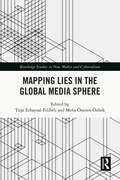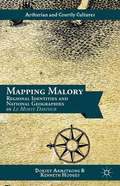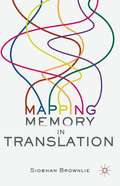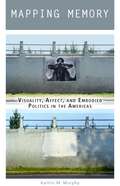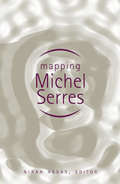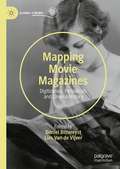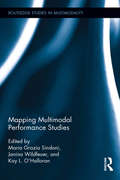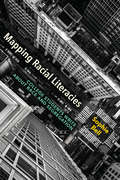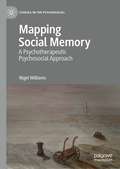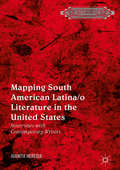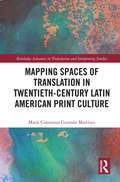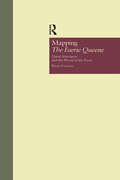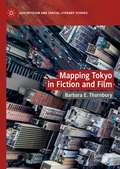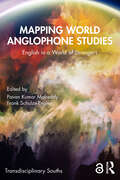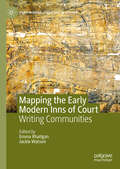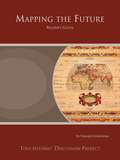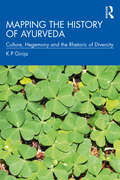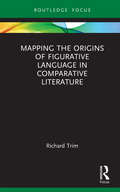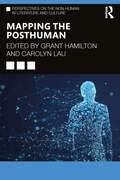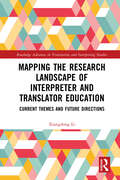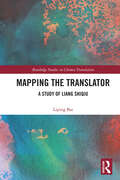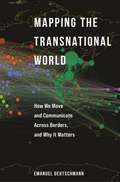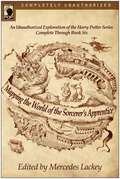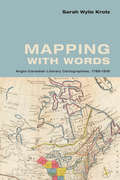- Table View
- List View
Mapping Lies in the Global Media Sphere (Routledge Studies in New Media and Cyberculture)
by Tirşe Erbaysal-Filibeli Melis Öneren-ÖzbekThis volume addresses the concept of “(in)nocent lies” in the media – beyond the concept of misleading information online, this extends to a deliberate effort to spread misinformation, disinformation and conspiracy theories – and proposes a critical approach to tackle the issue in related interdisciplinary fields. The book takes a multidisciplinary and international approach, addressing the digital divide and global inequality, as well as algorithmic bias, how misinformation harms vulnerable groups, social lynching and the effect of misinformation on certain social, political and cultural agendas, among other topics. Arranged thematically, the chapters paint a nuanced and original picture of this issue. This book will be of interest to students and academics in the areas of digital media, media and politics, journalism, development studies, gender and race.
Mapping Malory
by Dorsey Armstrong Kenneth HodgesMedievalists are increasingly grappling with spatial studies. This timely book argues that geography is a crucial element in Sir Thomas Malory's M orte Darthur and contributors shine a light on questions of politics and genre to help readers better understand Malory's world.
Mapping Memory in Translation
by Siobhan BrownlieThis book presents a map of the application of memory studies concepts to the study of translation. A range of types of memory from personal memory and electronic memory to national and transnational memory are discussed, and links with translation are illustrated by detailed case studies.
Mapping Memory: Visuality, Affect, and Embodied Politics in the Americas
by Kaitlin M. MurphyIn Mapping Memory, Kaitlin M. Murphy investigates the use of memory as a means of contemporary sociopolitical intervention. Mapping Memory focuses specifically on visual case studies, including documentary film, photography, performance, new media, and physical places of memory, from sites ranging from the Southern Cone to Central America and the U.S.–Mexican borderlands. Murphy develops new frameworks for analyzing how visual culture performs as an embodied agent of memory and witnessing, arguing that visuality is inherently performative. By analyzing the performative elements, or strategies, of visual texts—such as embodiment, reenactment, haunting, and the performance of material objects and places Murphy elucidates how memory is both anchored in and extracted from specific bodies, objects, and places. Drawing together diverse theoretical strands, Murphy originates the theory of “memory mapping”, which tends to the ways in which memory is strategically deployed in order to challenge official narratives that often neglect or designate as transgressive certain memories or experiences. Ultimately, Murphy argues, memory mapping is a visual strategy to ask, and to challenge, why certain lives are rendered visible and thus grievable and others not.
Mapping Michel Serres
by Niran AbbasThe work of Michel Serres---including the books Hermes, The Parasite, The Natural Contract, Genesis, The Troubadour of Knowledge, and Conversations on Science, Culture, and Time---has stimulated readers for years, as it challenges the boundaries of science, literature, culture, language, and epistemology. The essays in Mapping Michel Serres, written by the leading interpreters of his work, offer perspectives from a range of disciplinary positions, including literature, language studies, and cultural theory. Contributors include Maria Assad, Hanjo Berressem, Stephen Clucas, Steven Connor, Andrew Gibson, René Girard, Paul Harris, Marcel Hénaff, William Johnsen, William Paulson, Marjorie Perloff, Philipp Schweighauser, Isabella Winkler, and Julian Yates.
Mapping Movie Magazines: Digitization, Periodicals and Cinema History (Global Cinema)
by Daniel Biltereyst Lies Van de VijverMovie magazines are crucial but widely underused sources for writing the history of films and cinema. This volume brings together for the first time a wide variety of historic research of movie magazines and film trade journals, reflecting on the issue of using these sources for film/cinema historiography and on the impact of digitization processes. Mapping Movie Magazines explores this debate from different disciplinary perspectives, enlightened by case studies from the use of early film trade press to pedagogical uses of digitized periodicals. The volume explores Hollywood’s grip on movie magazines, gender in film journalism, typologies of unknown trade press and movie magazine markets, and subversive Tijuana bibles.
Mapping Multimodal Performance Studies (Routledge Studies in Multimodality)
by Kay O'Halloran Janina Wildfeuer Maria Grazia SindoniThis book is a first attempt to map the broad context of performance studies from a multimodal perspective. It collects original research on traditional performing arts (theatre, dance, opera), live (durational performance) and mediated/recorded performances (films, television shows), as well as performative discursive practices on social media by adopting several theories and methodologies all dealing with the notion of multimodality. As a mostly dynamic and also interactive environment for various text types and genres, the context of performance studies provides many opportunities to produce meaning verbally and non-verbally. All chapters in this book develop frameworks for the analysis of performance-related events and activities and explore empirical case studies in a range of different ages and cultures. A further focus lies on the communicative strategies deployed by different communities of practice, taking into account processes of production, distribution, and consumption of such texts in diverse spatial and temporal contexts.
Mapping Mythologies
by Marilyn ButlerIn this groundbreaking work of revisionary literary history, Marilyn Butler traces the imagining of alternative versions of the nation in eighteenth-century Britain, both in the works of a series of well-known poets (Akenside, Thomson, Gray, Collins, Chatterton, Macpherson, Blake) and in the differing accounts of the national culture offered by eighteenth-century antiquarians and literary historians. She charts the beginnings in eighteenth-century Britain of what is now called cultural history, exploring how and why it developed, and the issues at stake. Her interest is not simply in a succession of great writers, but in the politics of a wider culture, in which writers, scholars, publishers, editors, booksellers, readers all play their parts. For more than thirty years, Marilyn Butler was a towering presence in eighteenth-century and romantic studies, and this major work is published for the first time.
Mapping Racial Literacies: College Students Write about Race and Segregation
by Sophie R. BellEarly college classrooms provide essential opportunities for students to grapple and contend with the racial geographies that shape their lives. Based on a mixed methods study of students’ writing in a first-year-writing course themed around racial identities and language varieties at St. John’s University, Mapping Racial Literacies shows college student writing that directly confronts lived experiences of segregation—and, overwhelmingly, of resegregation. This textual ethnography embeds early college students’ writing in deep historical and theoretical contexts and looks for new ways that their writing contributes to and reshapes contemporary understandings of how US and global citizens are thinking about race. The book is a teaching narrative, tracing a teaching journey that considers student writing not only in the moments it is assigned but also in continual revisions of the course, making it a useful tool in helping college-age students see, explore, and articulate the role of race in determining their life experiences and opportunities. Sophie Bell’s work narrates the experiences of a white teacher making mistakes in teaching about race and moving forward through those mistakes, considering that process valuable and, in fact, necessary. Providing a model for future scholars on how to carve out a pedagogically responsive identity as a teacher, Mapping Racial Literacies contributes to the scholarship on race and writing pedagogy and encourages teachers of early college classes to bring these issues front and center on the page, in the classroom, and on campus.
Mapping Social Memory: A Psychotherapeutic Psychosocial Approach (Studies in the Psychosocial)
by Nigel WilliamsThis book is grounded in psychosocial research that explores the complex intergenerational transmission of memories within families and the transgenerational social issues that form a part of those memories. The author demonstrates that the organising framework of moving back and forth between inter- and transgenerational processes is key to mapping those relationships leading to the ideas of generational companionship, a multigenerational self and intergenerational mentalisation. Drawing on sociological and psychoanalytic approaches, it provides a framework for thinking about continuity and discontinuity in the lives of individuals and in the longer sweep of the generations. The role and potential for a psychosocial approach in deep-level problem solving is addressed through chapters on psychotherapy and on psychosocial interventions. Social imagination in personal and social healing is a core theme, as is the study of the relationship between creative and destructive forces that play out in human life. The book will be an invaluable resource for students and scholars of psychosocial research and psychotherapy as well as in memory studies, history, genealogy and social theory.
Mapping South American Latina/o Literature in the United States: Interviews With Contemporary Writers (Literatures of the Americas)
by Juanita HerediaThis collection of interviews demonstrates that U.S. Latinas/os of South American background have contributed pioneering work to U.S. Latina/o literature and culture in the twenty-first century. In conversation with twelve significant authors of South American descent in the United States, Juanita Heredia reveals that, through their transnational experiences, they have developed multicultural identities throughout different regions and cities across the country. However, these authors' works also exemplify a return to their heritage in South America through memory and travel, often showing that they maintain strong cultural and literary ties across national borders. As such, they have created a new chapter in trans-American history by finding new ways of imagining South America from their formation and influences in the U.S.
Mapping Spaces of Translation in Twentieth-Century Latin American Print Culture (Routledge Advances in Translation and Interpreting Studies)
by María Constanza GuzmánThis book reflects on translation praxis in 20th century Latin American print culture, tracing the trajectory of linguistic heterogeneity in the region and illuminating collective efforts to counteract the use of translation as a colonial tool and affirm cultural production in Latin America. In investigating the interplay of translation and the Americas as a geopolitical site, Guzmán Martínez unpacks the complex tensions that arise in these “spaces of translation” as embodied in the output of influential publishing houses and periodicals during this time period, looking at translation as both a concept and a set of narrative practices. An exploration of these spaces not only allows for an in-depth analysis of the role of translation in these institutions themselves but also provides a lens through which to uncover linguistic plurality and hybridity past borders of seemingly monolingual ideologies. A concluding chapter looks ahead to the ways in which strategic and critical uses of translation can continue to build on these efforts and contribute toward decolonial narrative practices in translation and enhance cultural production in the Americas in the future. This book will be of particular interest to scholars in translation studies, Latin American studies, and comparative literature.
Mapping The Faerie Queene: Quest Structures and the World of the Poem (Garland Studies in the Renaissance #3)
by Wayne EricksonFirst published in 1996. Routledge is an imprint of Taylor & Francis, an informa company.
Mapping Tokyo in Fiction and Film (Geocriticism and Spatial Literary Studies)
by Barbara E. ThornburyMapping Tokyo in Fiction and Film explores ways that late 20th- and early 21st- century fiction and film from Japan literally and figuratively map Tokyo. The four dozen novels, stories, and films discussed here describe, define, and reflect on Tokyo urban space. They are part of the flow of Japanese-language texts being translated (or, in the case of film, subtitled) into English. Circulation in professionally translated and subtitled English-language versions helps ensure accessibility to the primarily anglophone readers of this study—and helps validate inclusion in lists of world literature and film. Tokyo’s well-established culture of mapping signifies much more than a profound attachment to place or an affinity for maps as artifacts. It is, importantly, a counter-response to feelings of insecurity and disconnection—insofar as the mapping process helps impart a sense of predictability, stability, and placeness in the real and imagined city.
Mapping World Anglophone Studies: English in a World of Strangers (Transdisciplinary Souths)
by Pavan Kumar Malreddy Frank Schulze-EnglerThis book explores core issues in the emerging field of World Anglophone Studies. It shows that traditional frameworks based on the colonial and imperial legacies of English need to be revised and extended to understand the complex adaptations, iterations, and incarnations of English in the contemporary world.The chapters in this volume make three significant interventions in the field: First, they showcase the emergence of Anglophone literatures and cultures in parts of the world not traditionally considered Anglophone – Cuba, the Arab world, the Balkan region, Vietnam, Algeria, and Belize, among others Second, they feature new zones of contact and creolization between Anglophone literatures, cultures, and languages such as Swahili, Santhali, Ojibway, and Hindi, as well as Anglophone representations of colonial encounters and contemporary experiences in non-Anglophone settings such as Cuba, Angola, and Algeria And finally, the volume turns to Anglophone literary and cultural productions on new platforms such as social media and Netflix and highlights the role of English in emergent sites of resistance involving women, Indigenous populations, queer and other non-heteronormative sexualities, as well as post-conflict societies Mapping linguistic transgressions and the transmigration of cultural tropes between Englishes, vernaculars, and a wide variety of other languages with a rich set of case studies, this volume will be essential reading for courses such as world literatures in English, postcolonial studies, anglophone studies, literature and culture, Indian Ocean worlds, Global Englishes, and Global South studies.
Mapping the Early Modern Inns of Court: Writing Communities (Early Modern Literature in History)
by Emma Rhatigan Jackie WatsonThis collection of essays presents recent research on the Inns of Court and their place in the literature and culture of the early modern world. The volume is structured in three sections. Section One looks at the institutional spaces of the Inns themselves. The chapters consider how the Innsmen&’s identities and writings were shaped by their participation in the communal life of the legal Societies. Section Two looks at the Inns in the context of early modern London. The chapters attend to the intellectual and cultural traffic between the Inns and the city in which they were located by examining the role of Innsmen in the book trade, the circulation of manuscripts, playhouses, and musical culture. Finally, Section Three sets a wider international context. The chapters focus on the role of Innsmen in translation, nation-building, and early colonisation. Together these sections attend to the Innsmen not only as writing communities in themselves, but as participants in a complex of intersecting networks reaching out into London and beyond.
Mapping the Future, Reader's Guide
by Howard ZeidermanDiscussion Educational materials for College/Executive
Mapping the History of Ayurveda: Culture, Hegemony and the Rhetoric of Diversity
by K P GirijaThis book looks at the institutionalisation and refashioning of Ayurveda as a robust, literate classical tradition, separated from the assorted, vernacular traditions of healing practices. It focuses on the dominant perspectives and theories of indigenous medicine and various compulsions which led to the codification and standardisation of Ayurveda in modern India. Critically engaging with authoritative scholarship, the book extrapolates from some of these theories, raising significant questions on the study of alternative knowledge practices. By using case studies of the southern Indian state of Kerala – which is known globally for its Ayurveda – it provides an in-depth analysis of local practices and histories. Drawing from interviews of practitioners, archival documents, vernacular texts and rare magazines on Ayurveda and indigenous medicine, it presents a nuanced understanding of the relationships between diverse practices. It highlights the interactions as well as the tensions within them, and the methods adopted to preserve the uniqueness of practices even while sharing elements of healing, herbs and medicine. It also discusses how regulations and standards set by the state have estranged assorted healing practices, created uncertainties and led to the formation of categories like Ayurveda and nattuvaidyam (indigenous medicine/ayurvedas). Lucid and topical, the book will be useful for researchers and people interested in social medicine, history of medicine, Ayurveda, cultural studies, history, indigenous studies, and social anthropology.
Mapping the Origins of Figurative Language in Comparative Literature (Routledge Focus on Literature)
by Richard TrimThis book investigates the origins of figurative language in literary discourse within a cognitive framework. It represents an interface between linguistics and literature and develops a 6-tier theoretical model which analyses the different factors contributing to the creation of figurative words and expressions. By examining features ranging from language structure to figurative thought, cultural history, reference, narrative and the personal experience of authors, it develops a global overview of the processes involved. Due to its particularly innovative characteristics in literature, the theme of death is explored in relation to universal concepts such as love and time. These aspects are discussed in the light of well-known authors in comparative literature such as D.H. Lawrence, Simone De Beauvoir, Hermann Hesse and Jorge Luis Borges. The origins can involve complex conceptual mappings in figures of speech such as metaphor and symbolism. They are often at the roots of an author’s personal desires or represent the search for answers to human existence. This approach offers a wide variety of new ideas and research possibilities for postgraduate and research students in modern languages, linguistics and literature. It would also be of interest to academic researchers in these disciplines as well as the general public who would like to delve deeper into the relevant fields.
Mapping the Posthuman (Perspectives on the Non-Human in Literature and Culture)
by Grant Hamilton and Carolyn LauThis book works to delineate some of the major routes by which science and art intersect. Structured according to the origin myths of the posthuman that continue to shape the idea of the human in our technological modernity, this volume gives space to narratives of alter-modernity that resonate with Ursula K. Le Guin’s call for a new kind of story which exposes the violence and exploitation driven by a sustained belief in human exceptionalism, anthropocentrism, and cultural superiority. In this context, the posthuman myths of multispecies flourishing given in this collection, which are situated across a range of historical times and locations, and media and modalities, are to be thought of as kernels of possible futures that can only be realized through collective endeavour.
Mapping the Research Landscape of Interpreter and Translator Education: Current Themes and Future Directions (Routledge Advances in Translation and Interpreting Studies)
by Xiangdong LiMapping the Research Landscape of Interpreter and Translator Education explores research themes in interpreter and translator education based on a systematic review of more than 20 years of research in the field. The book focuses on the ten research themes on the chain of curriculum development and evaluation, specifically, market needs analysis, content conceptualisation, learning needs analysis, teaching objectives, teaching beliefs, syllabus design, material development, instruction and/or effect, assessment, and course evaluation. It also touches upon the other 14 research themes, for example, trainer education, admissions, learner traits, thesis and research training, pre-service preparation, certification, in-service training, client education, and translation and interpreting as a means to education. The discussion of each theme is accompanied by a synthesis of its sub-themes, typical research cases, research prospects, and suggested reading. As a guide, it supports teachers by illustrating how to combine teaching and research in university settings and offers ways to integrate research into pedagogy.This book is a go-to reference for trainers and a hands-on guide for academics, researchers, and postgraduate students specialising in translation and interpreting curriculum development and pedagogy research.
Mapping the Translator: A Study of Liang Shiqiu (Routledge Studies in Chinese Translation)
by Liping BaiIn Mapping the Translator: A Study of Liang Shiqiu, the writer studies Liang Shiqiu (1903–1987), who was not only a famous writer and important critic but also one of the most prominent translators in China in the 20th century, most notably the first Chinese to finish a translation of The Complete Works of William Shakespeare. Based on primary sources, this research covers issues related to the historical, cultural, cognitive and sociological dimensions of translator studies. It investigates Liang’s translation poetics; the influences of possible patrons and professionals on him; the relationship between Liang’s ideology, the dominant ideology and his translation; Liang’s debates with Lu Xun about and beyond translation criteria, and whether there is inconsistency or possible contradiction in Liang’s translation poetics. This book also analyses the similarities and differences between Liang Shiqiu and Wu Mi–two followers of Irving Babbitt–in terms of translation poetics, and further explores the reasons leading to such differences. This book is targeted at scholars and students, both undergraduate and postgraduate, in the fields of translation studies, Asian studies, Chinese studies, and literary studies.
Mapping the Transnational World: How We Move and Communicate across Borders, and Why It Matters (Princeton Studies in Global and Comparative Sociology)
by Emanuel DeutschmannA study of the structure, growth, and future of transnational human travel and communicationIncreasingly, people travel and communicate across borders. Yet, we still know little about the overall structure of this transnational world. Is it really a fully globalized world in which everything is linked, as popular catchphrases like “global village” suggest? Through a sweeping comparative analysis of eight types of mobility and communication among countries worldwide—from migration and tourism to Facebook friendships and phone calls—Mapping the Transnational World demonstrates that our behavior is actually regionalized, not globalized.Emanuel Deutschmann shows that transnational activity within world regions is not so much the outcome of political, cultural, or economic factors, but is driven primarily by geographic distance. He explains that the spatial structure of transnational human activity follows a simple mathematical function, the power law, a pattern that also fits the movements of many other animal species on the planet. Moreover, this pattern remained extremely stable during the five decades studied—1960 to 2010. Unveiling proximity-induced regionalism as a major feature of planet-scale networks of transnational human activity, Deutschmann provides a crucial corrective to several fields of research.Revealing why a truly global society is unlikely to emerge, Mapping the Transnational World highlights the essential role of interaction beyond borders on a planet that remains spatially fragmented.
Mapping the World of the Sorcerer's Apprentice: An Unauthorized Exploration of the Harry Potter Series
by Mercedes Lackey and Leah WilsonFrom the Dursleys as social commentary to a look at Snape's role in less than child-friendly fanfiction . . . from the parallels between Azkaban and Abu Ghraib to the role of religion at Hogwarts . . . from why Dumbledore had to die to why killing Harry never should have been part of Voldemort's plan to begin with . . . Mapping the World of the Sorcerer's Apprentice offers a comprehensive look at the Harry Potter series through the eyes of leading science fiction and fantasy writers and religion, psychology, and science experts. This book has not been authorized by J. K. Rowling, Warner Bros. or anyone associated with the Harry Potter books or films.
Mapping with Words: Anglo-Canadian Literary Cartographies, 1789-1916
by Sarah Wylie KrotzMapping with Words re-conceptualizes settler writing as literary cartography. The topographical descriptions of early Canadian settler writers generated not only picturesque and sublime landscapes, but also verbal maps. These worked to orient readers, reinforcing and expanding the cartographic order of the emerging colonial dominion. Drawing upon the work of critical and cultural geographers as well as literary theorists, Sarah Wylie Krotz opens up important aesthetic and political dimensions of both familiar and obscure texts from the nineteenth century, including Thomas Cary’s Abram’s Plains, George Monro Grant’s Ocean to Ocean, and Susanna Moodie’s Roughing it in the Bush. Highlighting the complex territoriality that emerges from their cartographic aesthetics, Krotz offers fresh readings of these texts, illuminating their role in an emerging spatial imaginary that was at once deeply invested in the production of colonial spaces and at the same time enmeshed in the realities of confronting Indigenous sovereignties.
